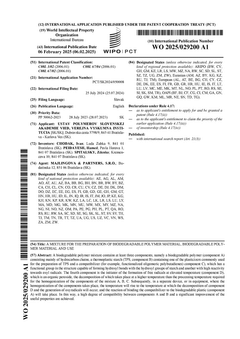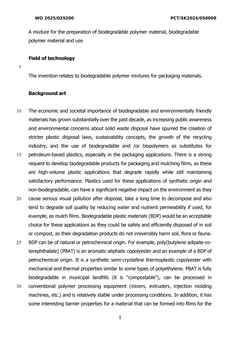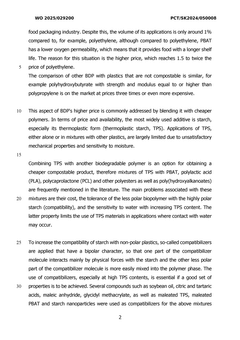Sustainable Biodegradable Plastics: Future of Eco-Friendly Packaging
Biodegradable Plastics Evolution and Objectives
Biodegradable plastics have emerged as a promising solution to address the growing environmental concerns associated with conventional plastic packaging. The evolution of these materials can be traced back to the 1980s when the first commercially viable biodegradable plastics were introduced. Initially, these early iterations faced challenges in terms of performance and cost-effectiveness, limiting their widespread adoption.
Over the past four decades, significant advancements have been made in the field of biodegradable plastics. The development of new materials, such as polylactic acid (PLA) and polyhydroxyalkanoates (PHAs), has greatly expanded the range of applications for biodegradable packaging. These materials offer improved mechanical properties, barrier characteristics, and processability, making them more competitive with traditional petroleum-based plastics.
The evolution of biodegradable plastics has been driven by a combination of factors, including increasing environmental awareness, stricter regulations on single-use plastics, and growing consumer demand for sustainable packaging solutions. This has led to a surge in research and development efforts aimed at improving the performance and reducing the cost of biodegradable materials.
One of the key objectives in the field of biodegradable plastics is to achieve a balance between functionality and environmental impact. Researchers are focusing on developing materials that can maintain their structural integrity during use but degrade rapidly and safely once disposed of in appropriate conditions. This includes efforts to optimize the degradation rates and ensure complete biodegradation without leaving harmful residues.
Another important goal is to expand the feedstock options for biodegradable plastics. While many current materials are derived from renewable resources such as corn or sugarcane, there is a growing interest in utilizing agricultural waste, algae, and other non-food biomass sources. This approach aims to address concerns about competition with food production and further reduce the environmental footprint of biodegradable plastics.
Improving the scalability and cost-effectiveness of production processes is also a critical objective. As demand for biodegradable packaging increases, researchers are working on developing more efficient manufacturing techniques and exploring ways to integrate these materials into existing plastic production infrastructure.
Looking ahead, the field of biodegradable plastics for eco-friendly packaging is poised for continued growth and innovation. The ultimate goal is to create a circular economy for plastics, where materials are designed to be reused, recycled, or fully biodegraded, minimizing waste and environmental impact. This vision drives ongoing research into new materials, improved degradation mechanisms, and more sustainable production methods.
Eco-Friendly Packaging Market Analysis
The eco-friendly packaging market has experienced significant growth in recent years, driven by increasing environmental awareness and stringent regulations on plastic waste. This market segment encompasses a wide range of sustainable packaging solutions, including biodegradable plastics, recycled materials, and plant-based alternatives. The global eco-friendly packaging market was valued at approximately $245 billion in 2022 and is projected to reach $380 billion by 2028, with a compound annual growth rate (CAGR) of 7.5% during the forecast period.
Consumer demand for sustainable packaging options has been a key driver of market growth. A survey conducted in 2022 revealed that 74% of consumers are willing to pay more for products packaged in eco-friendly materials. This shift in consumer preferences has prompted major brands and retailers to adopt sustainable packaging strategies, further fueling market expansion.
The food and beverage industry remains the largest end-user segment for eco-friendly packaging, accounting for over 40% of the market share. This is followed by the personal care and cosmetics sector, which has seen a surge in demand for sustainable packaging solutions in recent years. The e-commerce industry has also emerged as a significant contributor to market growth, with the rise of online shopping driving the need for sustainable packaging alternatives.
Geographically, Europe leads the eco-friendly packaging market, with countries like Germany, France, and the United Kingdom at the forefront of sustainable packaging innovations. North America follows closely, with the United States showing strong growth potential due to increasing environmental regulations and consumer awareness. The Asia-Pacific region is expected to witness the highest growth rate in the coming years, driven by rapid industrialization, urbanization, and growing environmental concerns in countries like China and India.
Key market trends include the development of advanced biodegradable materials, such as PLA (polylactic acid) and PHA (polyhydroxyalkanoates), which offer improved performance and biodegradability compared to traditional plastics. Additionally, there is a growing focus on circular economy principles, with companies investing in closed-loop recycling systems and designing packaging for easy recyclability.
Despite the positive outlook, the eco-friendly packaging market faces challenges such as higher production costs compared to conventional packaging materials and limitations in performance for certain applications. However, ongoing research and development efforts are addressing these issues, with innovations in material science and manufacturing processes expected to drive down costs and improve performance in the coming years.
Current Challenges in Sustainable Plastic Development
The development of sustainable biodegradable plastics for eco-friendly packaging faces several significant challenges. One of the primary obstacles is achieving comparable performance to traditional plastics while maintaining biodegradability. Current biodegradable plastics often lack the durability, strength, and barrier properties necessary for effective packaging, limiting their widespread adoption in various industries.
Cost-effectiveness remains a major hurdle in sustainable plastic development. The production of biodegradable plastics typically involves more complex processes and higher-priced raw materials, resulting in increased manufacturing costs. This price disparity makes it difficult for eco-friendly alternatives to compete with conventional plastics in the market, especially in price-sensitive sectors.
Another challenge lies in the standardization and certification of biodegradable plastics. The lack of universally accepted standards for biodegradability and compostability creates confusion among consumers and manufacturers. This ambiguity hampers the development of consistent waste management practices and infrastructure for these materials.
The scalability of production processes for sustainable plastics poses a significant challenge. Many promising biodegradable materials are still in the research or pilot stage, and scaling up their production to meet global demand requires substantial investment in infrastructure and technology. This scaling issue creates a bottleneck in the widespread adoption of sustainable packaging solutions.
Environmental impact assessment of biodegradable plastics throughout their lifecycle remains a complex task. While these materials offer benefits in terms of end-of-life disposal, their production may sometimes involve energy-intensive processes or the use of agricultural resources that could compete with food production. Balancing these factors to ensure a net positive environmental impact is an ongoing challenge.
The development of effective end-of-life management systems for biodegradable plastics presents another hurdle. Many existing recycling and waste management facilities are not equipped to handle these materials properly. This lack of infrastructure can lead to biodegradable plastics contaminating conventional plastic recycling streams or ending up in landfills where they may not degrade as intended.
Lastly, consumer education and acceptance pose significant challenges. Many consumers are unfamiliar with the proper disposal methods for biodegradable plastics or may not understand the differences between various eco-friendly packaging options. Overcoming these knowledge gaps and changing consumer behavior is crucial for the successful implementation of sustainable packaging solutions.
Existing Biodegradable Plastic Solutions
01 Biodegradable plastic compositions
Development of novel biodegradable plastic compositions using various natural and synthetic polymers. These compositions aim to improve the sustainability of plastic products by ensuring they break down naturally in the environment, reducing long-term pollution.- Biodegradable polymer compositions: Development of biodegradable polymer compositions that can be used as sustainable alternatives to conventional plastics. These compositions often include natural or synthetic polymers that can break down in the environment, reducing long-term environmental impact. The formulations may incorporate additives to enhance degradation rates or improve material properties.
- Production methods for biodegradable plastics: Innovative manufacturing processes for producing biodegradable plastics at scale. These methods focus on improving efficiency, reducing energy consumption, and minimizing waste during production. Techniques may include novel polymerization processes, use of renewable feedstocks, or integration of recycled materials into the production chain.
- Biodegradation enhancement techniques: Strategies to enhance the biodegradation rate of plastics in various environments. This may involve the incorporation of specific enzymes, microorganisms, or additives that accelerate the breakdown process. Research also focuses on optimizing the balance between material durability during use and rapid degradation after disposal.
- Life cycle assessment and sustainability metrics: Development of comprehensive life cycle assessment methodologies and sustainability metrics specific to biodegradable plastics. These tools help evaluate the overall environmental impact of biodegradable plastics from production to disposal, considering factors such as carbon footprint, water usage, and end-of-life scenarios.
- Biodegradable plastic applications: Exploration of novel applications for biodegradable plastics across various industries. This includes developing specialized formulations for packaging, agriculture, medical devices, and consumer goods. Research focuses on tailoring material properties to meet specific performance requirements while maintaining biodegradability.
02 Production methods for sustainable plastics
Innovative manufacturing processes for producing biodegradable plastics, focusing on energy-efficient and environmentally friendly methods. These techniques aim to reduce the carbon footprint of plastic production while maintaining product quality and performance.Expand Specific Solutions03 Biodegradation enhancement techniques
Methods to improve the biodegradability of plastics, including the use of additives, enzymes, or specific microorganisms. These techniques aim to accelerate the breakdown of plastic materials in various environmental conditions, enhancing their overall sustainability.Expand Specific Solutions04 Recycling and circular economy approaches
Strategies for integrating biodegradable plastics into circular economy models, including efficient recycling processes and the development of closed-loop systems. These approaches aim to maximize resource utilization and minimize waste in the plastic lifecycle.Expand Specific Solutions05 Applications of sustainable biodegradable plastics
Exploration of various applications for biodegradable plastics across industries, including packaging, agriculture, and consumer goods. This research focuses on developing sustainable alternatives to traditional plastics while maintaining or improving functionality.Expand Specific Solutions
Key Players in Sustainable Packaging Industry
The sustainable biodegradable plastics market for eco-friendly packaging is in a growth phase, driven by increasing environmental concerns and regulatory pressures. The global market size is expanding rapidly, with projections indicating significant growth in the coming years. Technologically, the field is advancing but still evolving, with various companies at different stages of development. Key players like Danimer IPCo LLC, CJ CheilJedang Corp., and Kingfa Sci. & Tech. Co., Ltd. are pushing the boundaries of innovation. Academic institutions such as Tsinghua University and Industrial Technology Research Institute are contributing to fundamental research. The involvement of major corporations like China Petroleum & Chemical Corp. indicates the industry's potential, while specialized firms like Earthform Co., Ltd. and Guangdong Shuye Environmental Protection Packaging Co., Ltd. are focusing on niche applications.
Toyo Seikan Co., Ltd.
Kingfa Sci. & Tech. Co., Ltd.
Innovative Biodegradable Polymer Research
- A biodegradable and biocompostible packaging material comprising at least one biopolymer, such as gellan, pectin, or alginate, combined with polyvinyl alcohol, and optionally coated with waxes or chitosan, is prepared through a film casting process, offering tunable moisture permeability and enhanced tensile strength.
- A mixture comprising 1 to 99 parts by weight of a biodegradable polymer with at least 30% secondary or tertiary hydrogens, 99 to 1 parts by weight of thermoplastic starch or native starch with a plasticizer, 0.02 to 12 parts by weight of a compatibilizer formed by oligomeric polymers of liquid rubbers, and 0.1 to 5 parts by weight of an organic peroxide initiator, which enhances compatibility and processing properties.
Environmental Impact Assessment
The environmental impact assessment of sustainable biodegradable plastics for eco-friendly packaging is a critical component in evaluating their overall sustainability and potential for widespread adoption. These materials offer promising alternatives to conventional plastics, potentially reducing the accumulation of plastic waste in landfills and oceans.
Biodegradable plastics, when properly disposed of, can decompose into natural elements through microbial activity, significantly reducing their environmental footprint. This process can occur in various environments, including industrial composting facilities, home composting systems, and even marine environments, depending on the specific type of biodegradable plastic.
One of the primary environmental benefits of biodegradable plastics is the reduction of plastic pollution. Unlike traditional plastics that persist in the environment for hundreds of years, biodegradable alternatives can break down within months to a few years, minimizing long-term ecological damage. This characteristic is particularly crucial for packaging materials, which often have short use cycles but long environmental persistence.
However, the environmental impact of biodegradable plastics extends beyond their end-of-life phase. The production process of these materials must also be considered. Many biodegradable plastics are derived from renewable resources such as corn, sugarcane, or cellulose. While this reduces dependence on fossil fuels, it raises concerns about land use and potential competition with food crops.
The carbon footprint of biodegradable plastics throughout their lifecycle is another crucial factor. Studies have shown that some biodegradable plastics may have a lower carbon footprint compared to conventional plastics, particularly when considering end-of-life scenarios. However, this can vary depending on the specific material and production methods used.
Water consumption and pollution during the production and disposal phases are also important considerations. Some biodegradable plastics may require more water in their production process compared to conventional plastics. Additionally, the breakdown of certain biodegradable materials in aquatic environments could potentially lead to temporary increases in nutrient levels, affecting local ecosystems.
The impact on soil quality is another aspect to consider, especially for biodegradable plastics designed for agricultural applications. While these materials can reduce plastic accumulation in soil, their decomposition products and potential effects on soil microorganisms need to be thoroughly assessed to ensure long-term soil health.
In conclusion, while sustainable biodegradable plastics for eco-friendly packaging offer significant environmental benefits, particularly in reducing plastic pollution, a comprehensive environmental impact assessment must consider their entire lifecycle. This includes raw material sourcing, production processes, use phase, and end-of-life scenarios to ensure that these materials truly represent a more sustainable alternative to conventional plastics.
Regulatory Framework for Biodegradable Materials
The regulatory framework for biodegradable materials plays a crucial role in the development and adoption of sustainable packaging solutions. As the global focus on environmental protection intensifies, governments and international organizations are establishing comprehensive guidelines and standards to ensure the proper use and disposal of biodegradable plastics.
At the forefront of these regulations is the European Union (EU), which has implemented stringent requirements through its Packaging and Packaging Waste Directive. This directive sets clear targets for the reduction of packaging waste and promotes the use of biodegradable materials. The EU has also introduced the EN 13432 standard, which specifies the requirements for packaging to be considered compostable and biodegradable.
In the United States, the Federal Trade Commission (FTC) has issued Green Guides to prevent deceptive marketing claims related to biodegradable products. These guidelines require manufacturers to provide scientific evidence supporting their biodegradability claims. Additionally, several states have enacted their own regulations, such as California's SB 567, which sets strict criteria for labeling products as biodegradable.
Asian countries are also making significant strides in regulating biodegradable materials. Japan has implemented the GreenPla certification system, which evaluates the biodegradability and safety of bioplastics. China has introduced the GB/T 20197 standard for biodegradable plastics, aligning with international norms while addressing local environmental concerns.
International standards organizations play a vital role in harmonizing global regulations. The International Organization for Standardization (ISO) has developed several standards, including ISO 17088 for compostable plastics and ISO 14851 for determining the aerobic biodegradability of plastic materials in an aqueous medium.
Despite these advancements, challenges remain in creating a unified global regulatory framework. Differences in testing methodologies, disposal infrastructure, and environmental conditions across regions complicate the establishment of universally applicable standards. Furthermore, the rapid pace of innovation in biodegradable materials often outpaces regulatory updates, necessitating frequent revisions to existing guidelines.
To address these challenges, there is a growing trend towards collaborative efforts between governments, industry stakeholders, and research institutions. These partnerships aim to develop more comprehensive and adaptable regulatory frameworks that can keep pace with technological advancements while ensuring environmental protection and consumer safety.
As the field of sustainable biodegradable plastics continues to evolve, regulatory bodies must maintain a delicate balance between encouraging innovation and enforcing rigorous standards. The future of regulatory frameworks in this domain will likely focus on lifecycle assessments, circular economy principles, and the development of more sophisticated biodegradability testing methods to accurately simulate real-world conditions.



